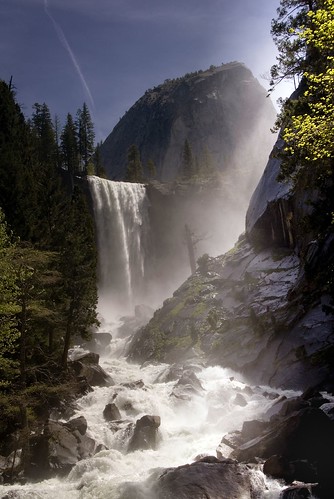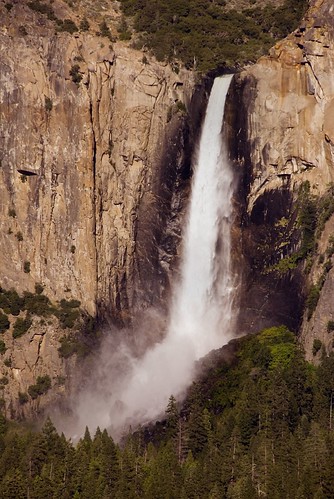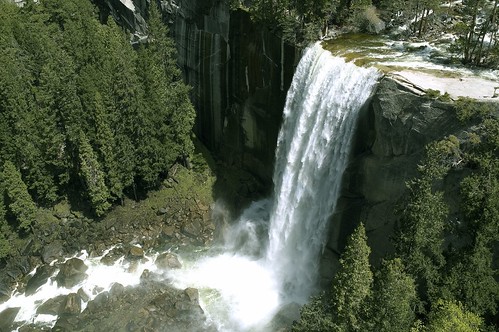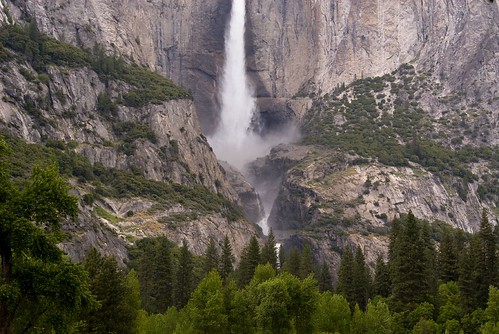Every view in Yosemite Valley has probably been photographed, and most views more than once. The famous vistas have been photographed a great many times. For example, there’s a classic Ansel Adams view of Vernal Falls that must have been taken from very close to my position when I took the photo shown above a few days ago.
These days one of the biggest challenges as a photographer in Yosemite is fighting one’s way through the groups of photographers that can block the famous locations. For example, it is impossible to visit Tunnel View in the afternoon without finding a horde of fifty or so photographers with tripods.
Most of the images that all these photographers take (my own and Ansel Adams’s included) portray a view of unspoiled nature. The very fact that these phorographers come in packs shows this for a lie—Yosemite is not empty and unspoiled nature, it is filled with people including other photographers.
By the way, the obsession with photographing Yosemite goes way back—more or less to the European discovery of the valley. A few years after its “discovery” there were already competing photographers in the valley, for example Eadweard Muybridge and Carleton Watkins struggling to produce the most impressive wet-plate vistas during the same season in the valley in 1872.
The photographic lie that Yosemite is not peopled cloaks a bigger (and related) untruth: that Yosemite itself is (and was) an unpeopled wilderness (leaving aside photographers and other tourists). This lie was spread by photographers from the very beginning: witha few exceptions, the early epic photos tell the story that Yosemite was an unpeopled wilderness when it was “discovered.”
People have always lived in Yosemite. The fact is that the Miwoks lived in Yosemite Valley, but were rapidly pushed out to make way for tourism. Today, employees of the National Park Service and the Delaware North Corporation (the park concessionaire) live in the valley. As far as I am concerned it is no consolation, but you can view the recreation of a Miwok village at the Yosemite museum, along with some waxworks models of what the Miwok may have looked like.
The Miwoks named the great waterfalls. What we call Bridalveil Falls was Pohono, “Spirit of the Wind,” shown here in my modern view from between the legs of the crowd at Tunnel View:
View this photograph larger.
I’ve already remarked that I despise the naming of the great trees of Yosemite and Sequoia after our generals of war. Essentially, this kind of naming is an act of cultural imperialism, along with blanking-out the Miwok names. As far as that goes, I like “Spirit of the Wind” as a name much better than the Victorian, vaguely insipid, Bridalveil Falls. The waterfall does seem to respond to the vagaries of the wind. It is the spirit of the wind, and it is no bride’s veil I have ever seen.
Other Miwok names are even more murky and lost in the mists of time than that of Pohono. The Miwok name for Vernal Falls (at least this American name is vaguely poetic) was Yan-o-pah. I haven’t been able to find out what the name means, and even figures such as the semi-disreputable and definitely iconoclastic Muybridge back when there were still Miwok seems to have got it wrong. Muybridge’s photograph of Vernal Falls is captioned “Pi-Wi-Ack, Valley of the Yosemite.” (Pi-Wi-Ack may have been the Miwok name for the entire valley.)
To Muybridge’s credit, he seems to used Miwok place names in his Yosemite photographs in a polemical fashion, and a number of his photographs do feature the Miwok doing their natural thing, rather than the unpeopled grandeur of “natural” Yosemite, or another variation on the noble savage theme.
Muybridge’s “Pi-Wi-Ack, Valley of the Yosemite,” taken in 1872, shows the top of Vernal Falls without the massive fence it has today, and without people. You can see a small reproduction of this photograph in this San Francisco Chronicle article, and a larger reproduction in Rebecca Solnit’s execellent critical biography of Eadweard Muybridge, River of Shadows. As Muybridge was a murderer—he shot his wife’s lover at point blank range in the heart—and an inventor—of what more or less became motion picture technology—his life makes interesting reading even without the photography.
The top of Yan-o-pah came by its zero population denisty (and lack of “improvements”) naturally in Muybridge’s time, but today it takes Photoshop, as in this recreation of mine of the top of Vernal Falls without people:
The last of the great classic trinity of waterfall photographic subjects in Yosemite is Cho-Lack to the Miwok, and Yosemite Falls to us. Once again, the meaning of Cho-Lack is as lost (at least to me) as the water that rushes down the Merced to the great San Francisco Bay. Here’s a photo of Cho-Lack I took recently, with my digital camera on a tripod and a long exposure to create a continuous, white flowing effect for the motion of water—like that used perforce by the great nineteenth century photographers, because they had no choice, and their exposures had to be long. The editing out of people and their artifacts was accomplished with framing, not via Photoshop.
View this photograph larger.




Pingback: Photoblog 2.0: » Photoblog 2.0 Archive: » Vernal Falls In Autumn
Yosemite Indian
22 Jun 2006Beautiful photos. It is also nice to see great photos of my people’s ancient homeland.
Sorry, I am not a Miwok, but a Yosemite Mono Paiute. You see the Paiutes were the original people of Yosemite, Hetch Hetchy and Mono Lake. The Miwoks of the lower foothills were the ones who worked for James Savage or Jim Savage. That is one of the sad parts of history that people don’t know that the real people of Yosemite were actually Paiutes.
Dr. Lafayette H. Bunnell was the only person to meet and write about Chief Tenaya and his band. No other person, besides one embedded reporter, met and wrote about Chief Tenaya.
Here is the book on PDF file. You can actually download it and the truth will quickly appear.
http://esnips.com/web/YosemiteIndiansWebResearch
If you follow the instructions on this webpage after you download the book on pdf people can see this is the truth. Type in those few words and than read what comes up…yes, Mono Paiute.
Sadly Chief Bautista or Vow-chester was the chief of the Southern Sierra Miwuks at that time. He was the overseer for Jim Savage for his gold mines. They were also the scouts for Savage and the Mariposa Battalion. The leader of the Battalion noted that without their help they would never have found Chief Tenaya and his people. They had blocked his path when he and his people tried to escape to Mono Lake.
Great photos though.
Pingback: Photoblog 2.0: » Photoblog 2.0 Archive: » Winter in Yosemite
Yosemite Indian
22 Jul 2006Harold here are photos done by English photographer Eadweard Muybridge of a Yosemite Paiute village;
http://thehive.modbee.com/?q=node/1620
One of our people put this web blog of Eadweard Muybridge photos using their numerical sequence and came up with quite a surprise. You can see how Muybridge walked around the village taking photos.
Muybridge even took one of German painter Albert Bierstadt. the great early Yosemite painter, who was in the Paiute camp.
Sorry for the quality of the photos, but my friend had to lessen the properties for quicker viewing for people who have dail-up. You understand that when you do great photos like yours, sometimes you have to lessen the qualities to for the internet.
Here are some of the earliest photos of Paiutes in Yosemite, that are seldom seen;
http://www.yosemitecampers.com/discus/messages/29/2150.html?1145602942
Photos by Anthony, Reilly, Soule, Boysen and Watkins. Some of the most well known Yosemite photographers.
There photos documented early American Indian life in Yosemite. It amazes me how they captured every day simple life of Native Americans in Yosemite. I wish I knew all the names of everyone in those old photos. I know quite a few, but in those large groupings it is hard to tell.
I do know Captain John, Captain Jim, Captain Sam, Bridgeport Tom, Tom Hutchings, the Sabes, Maggie “Taboose” Howard, Mary Leonard, John Wilson, Sadie McGowan, Leanna Tom, Charlie Dick and other Paiutes are in many of those photos.
We really appreacite the early photographers work in documenting Yosemite Indians. Many of their descendents are alive today to see their ancestors because of these photographers.
Here are early photos of Hetch Hetchy, with early accounts of our people in the Valley;
http://thehive.modbee.com/?q=node/180
Pingback: Photoblog 2.0: » Photoblog 2.0 Archive: » Blizzard in Merced Gorge
Yosemite Indian
26 Jul 2006Beautiful shots. When you view the falls in a different light or angle you can see the faces of the rocks that surround Po-ho-no Falls.
Even though those non-Indians who tried to transcribe the meaning of Pohono, which they describe as “Spirit of the Puffing Wind”, it really meant “Spirit of the Blowing Mist, which is evil” in Paiute. In our language Poohe’yoo is “to blow” and Pooha’a is “to curse”.
We Yosemite Indians in olden times were afraid of the Pohono Falls or Bridal Veil. We would try to stay away from them in early times and would walk quickly by it. The falls were the home of the Lady of the Misty Waters, a spirit that was evil.
One of our people did a great write up about the Pohono Falls legend and myth. Which they re-called when watching the movie “The Lady of the Water”.
http://thehive.modbee.com/?q=node/1743
If you go back there and during the right light you can see the faces in the rocks. We Paiutes believe everything has a spirit and a life, good or bad.
On this page they try to focus on the tale and faces in the rocks.
Pingback: Photoblog 2.0: » Photoblog 2.0 Archive: » Snowstorm in Yosemite
Pingback: Photoblog 2.0: » Photoblog 2.0 Archive: » Snakes and Ladders
rpeters
29 Aug 2007Harold,
According to Wiki, http://en.wikipedia.org/wiki/Vernal_Fall,
Yan-o-pah means “little cloud”.
Ron Peters
Pingback: Yosemite Night | Photoblog 2.0